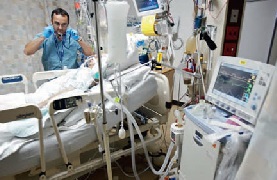BMC Infectious Diseases is delighted publish a special series entitled ‘How to treat severe infections in the ICU’. The series, commissioned by Dimitrios Matthaiou, has a broad focus and features reviews on everything from diagnostics to antibiotic resistance in the intensive care unit setting.

The treatment of Gram-positive bacteria, including methicillin-resistant Staphylococcus aureus (MRSA), in critically ill patients is explored in a review by Marin Kollef and colleagues. The rise in infectious caused by these agents is discussed, alongside the need for prompt and effective treatment with appropriate antibiotics.
Whilst the overall approach to treating infections in surgical patients is comparable to other patient groups Jan De Waele and Liesbet De Bus discuss the specific issues faced with these patients, including differences in sources of infection and microbial pattern.
Stijn I Blot and colleagues review methods for avoiding microaspiration, a significant risk factor for ventilator-associated pneumonia (VAP), and carefully consider the evidence as to whether each measure has been demonstrated to have an effect on VAP prevention.
What to do when your attempts to prevent VAP have been unsuccessful is explored by Bárbara Borgatta and Jordi Rello. As with other bacterial infections the need for early, effective treatment is underlined, along with the key set of questions the physician should ask themselves when determining which antibiotic(s) to use.
Treatment options for VAP become limited when the causative bacteria is multidrug resistant (MDR). José Garnacho-Montero and colleagues discuss just what those options are and the best approaches to dosing.

Jason Roberts and colleagues provide guidance on the use of therapeutic drug monitoring in the critically ill to optimize the exposure of antibiotics, improve clinical outcome and minimize the emergence of antibiotic resistance.
It’s not all bacterial infections though as Sotirios Tsiodras and colleagues discuss the treatment of viral infections in the ICU. When available antiviral therapy should be used appropriately but they also highlight the need got good supportive care.
In a further review Lara Zafrani and Elie Azoulay focus on neutropenic patients whose immune status means they are particularly vulnerable to infections. Whilst Jean-François Timsit and colleagues review treatment of bloodstream infections in the ICU setting.
Almudena Burillo and Emilio Bouza discuss the use of rapid diagnostic tests to identify infections in ICUs. As these tests become increasingly sophisticated turnaround times are shortened and the treatment of many types of infection can be optimized.
Finally we end with a plea from Jean Carlet and colleagues to prevent and reduce antibiotic resistance via the World Alliance Against Antibiotic Resistance (WAAAR).
We hope you enjoy reading the series as much as we have enjoyed working on it!
Comments